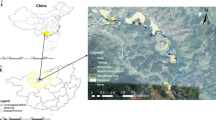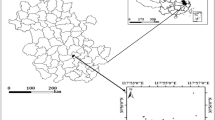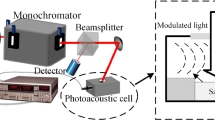Abstract
Rapid assessment of heavy metal (HM) pollution in mining areas is urgently required for further remediation. Here, hyperspectral technology was used to predict HM contents of multi-media environments (tailings, surrounding soils and agricultural soils) in a mining area. The correlation between hyperspectral data and HMs was explored, then the prediction models were established by partial least squares regression (PLSR) and back propagation neural networks (BPNN). The determination coefficients (R2), root mean squared error and ratios of performance to interquartile range (RPIQ) were used to evaluate the performance of the models. Results show that: (1) both PLSR and BPNN had good prediction ability, and (2) BPNN had better generalization ability (Cu (R2 = 0.89, RPIQ = 3.05), Sn (R2 = 0.86, RPIQ = 4.91), Zn (R2 = 0.74, RPIQ = 1.44) and Pb (R2 = 0.70, RPIQ = 2.10)). In summary, this study indicates that hyperspectral technology has potential application in HM estimation and soil pollution investigation in polymetallic mining areas.







Similar content being viewed by others
References
Acosta JA, Faz A, Martinez-Martinez S, Zornoza R, Carmona DM, Kabas S (2011) Multivariate statistical and GIS-based approach to evaluate heavy metals behaviour in mine sites for future reclamation. J Geochem Explor 109:8–17
Anawar HM (2015) Sustainable rehabilitation of mining waste and acid mine drainage using geochemistry, mine type, mineralogy, texture, ore extraction and climate knowledge. J Environ Manag 158(aug.1):111–121
Bellon-Maurel V, Fernandez-Ahumada E, Palagos B, Roger J-M, McBratney A (2010) Critical review of chemometric indicators commonly used for assessing the quality of the prediction of soil attributes by NIR spectroscopy. TrAC Trend Anal Chem 29(9):1073–1081
Clark RN, Roush TL (1984) Reflectance spectroscopy: quantitative analysis techniques for remote sensing applications. J Geophys Res 89:6329–6340
Cittadino A, Ocello N, Majul MV, Ajhuacho R, Igarzabal MA (2020) Heavy metal pollution and health risk assessment of soils from open dumps in the metropolitan area of buenos aires, Argentina. Environ Monit Assess 192(5):1–9
Chen H, Teng Y, Lu S, Wang Y, Wang J (2015) Contamination features and health risk of soil heavy metals in china. Sci Total Environ 512:143–153
Cooperative Research Group on Chinese Soil Taxonomy (CRG-CST) (2001) Chinese soil taxonomy. Science Press, Beijing, New York, pp 1–203
Dong J, Yang QW, Sun LN, Zeng Q, Liu SJ, Pan J, Liu XL (2011) Assessing the concentration and potential dietary risk of heavy metals in vegetables at a pb/zn mine site, china. Environ Earth Sci 64(5):1317–1321
Gan FP, Wang RS, Ma AN (2003) Spectral identification tree (sit) for mineral extraction based on spectral characteristics of minerals. Earth Sci Front 10(2):445–454
Hou L, Li X, Li F (2019) Hyperspectral-based inversion of heavy metal content in the soil of coal mining areas. J Environ Qual 48(1):57–63
Hu BF, Xue J, Zhou Y, Shao S, Fu ZY, Li Y, Chen SC, Qi L, Shi Z (2020) Modelling bioaccumulation of heavy metals in soil-crop ecosystems and identifying its controlling factors using machine learning. Environ Pollut 262:114308
Hu BF, Shao S, Ni H, Fu ZY, Hu LS, Zhou Y, Min XX, She SF, Chen SC, Huang MX, Zhou LQ, Li Y, Shi Z (2020) Current status, spatial features, health risks, and potential driving factors of soil heavy metal pollution in China at province level. Environ Pollut 266 Part 3:114961
Jiang QH, Li QX, Wang XG, Wu Y, Yang XL, Liu F (2017) Estimation of soil organic carbon and total nitrogen in different soil layers using VNIR spectroscopy: effects of spiking on model applicability. Geoderma 293:54–63
Kemper T, Sommer S (2002) Estimate of heavy metal contamination in soils after a mining accident using reflectance spectroscopy. Environ Sci Technol 36(12):2742–2747
Lenka D, Tomáš J, Lenka B (2017) Assessment of soil heavy metal pollution in a former mining area—before and after the end of mining activities. Soil Water Res 12(3):229–236
Li Y, Liu Y, Wu S, Wang C, Xu A, Pan X (2017) Hyper-spectral estimation of wheat biomass after alleviating of soil effects on spectra by non-negative matrix factorization. Eur J Agron 84:58–66
Li ZY, Ma ZW, Kuijp TJVD, Yuan ZW, Huang L (2014) A review of soil heavy metal pollution from mines in China: pollution and health risk assessment. Sci Total Environ 468-469C:843–853
Liang Y, Yi XY, Dang Z, Wang Q, Luo HM, Tang J (2017) Heavy metal contamination and health risk assessment in the vicinity of a tailing pond in Guangdong, china. Int J Environ Res Public Health 14(12):1557
Liu G, Zhou X, Li Q, Shi Y, Guo GL, Zhao L, Wang J, Su YQ, Zhang C (2020) Spatial distribution prediction of soil as in a large-scale arsenic slag contaminated site based on an integrated model and multi-source environmental data. Environ Pollut 267:115631
Liu M, Liu X, Li M, Fang M, Chi W (2010) Neural-network model for estimating leaf chlorophyll concentration in rice under stress from heavy metals using four spectral indices. Biosys Eng 106(3):223–233
Liu M, Liu X, Wu M, Li L, Xiu L (2011) Integrating spectral indices with environmental parameters for estimating heavy metal concentrations in rice using a dynamic fuzzy neural-network model. Comput Geosci 37(10):1642–1652
Liu WD (2002) Study on extraction of soil information and data mining by hyperspectral remote sensing. (Doctoral dissertation)
Liu WD, Frédéric B, Zhang B, Zheng LF, Tong QX (2004) Extraction of soil moisture information by hyperspectral remote sensing. Acta Pedol Sin 041(005):700–706 (in Chinese)
Malmir M, Tahmasbian I, Xu Z, Farrar MB, Bai SH (2019) Prediction of soil macro- and micro-elements in sieved and ground air-dried soils using laboratory-based hyperspectral imaging technique. Geoderma 340:70–80
Mouazen AM, Kuang B, Baerdemaeker JD, Ramon H (2010) Comparison among principal component, partial least squares and back propagation neural network analyses for accuracy of measurement of selected soil properties with visible and near infrared spectroscopy. Geoderma 158(1–2):23–31
Pause M, Schulz K, Zacharias S, Lausch A (2012) Near-surface soil moisture estimation by combining airborne l-band brightness temperature observations and imaging hyperspectral data at the field scale. J Appl Remote Sens 6(12):2981–2994
Qiao L, Chen LX, Duan WB, Song RQ, Wang XF (2011) Comparison of three multivariate methods of inferential modeling of soil organic matter using hyper spectra. International Conference on Remote Sensing. IEEE, Nanjing
Qu M, Chen J, Huang B, Zhao Y (2020) Enhancing apportionment of the point and diffuse sources of soil heavy metals using robust geostatistics and robust spatial receptor model with categorical soil-type data. Environ Pollut 265(Pt A):114964
Ren HY, Zhuang DF, Singh AN, Pan JJ, Qiu DS, Shi RH (2009) Estimation of as and cu contamination in agricultural soils around a mining area by reflectance spectroscopy:a case study. Pedosphere 19(6):719–726
Rocha Neto OCd, Teixeira ADS, Leão RAdO, Moreira LCJ, Galvão LS (2017) Hyperspectral remote sensing for detecting soil salinization using prospectir-vs aerial imagery and sensor simulation. Remote Sens 9(1):42
Rinnan Å, van den Berg F, Engelsen SB (2009) Review of the most common pre-processing techniques for near-infrared spectra. TrAC Trend Anal Chem 28:1201–1222
Rummelhart DE, Hinton GE, Williams RJ (1986) Learning internal representations by error propagation. Nature 323(2):318–362
Savitzky A, Golay MJE (1964) Smoothing and differentiation of data by simplified least squares procedures. Anal Chem 36:1627–1639
Simon H (1994) Neural network: a comprehensive foundation. Prentice Hall PTR, Hoboken
Song L, Jian J, Tan DJ, Xie HB, Luo ZF, Gao B (2015) Estimate of heavy metals in soil and streams using combined geochemistry and field spectroscopy in wan-sheng mining area, Chongqing, China. Int J Appl Earth Obs Geoinform 34:1–9
Song T, Fu X, Chen Y (2018) Remote Sensing Inversion of Soil Zinc pollution in Gejiu Mining Area of Yunnan. Remote Sens Technol Appl 33(1):88–95 (in Chinese)
Sun L, Guo DK, Liu K, Meng H, Zheng Y, Yuan FQ, Zhu GH (2019) Levels, sources, and spatial distribution of heavy metals in soils from a typical coal industrial city of Tangshan, China. Catena 175:101–109
Tan K, Wang H, Zhang Q, Jia X (2018) An improved estimation model for soil heavy metal(loid) concentration retrieval in mining areas using reflectance spectroscopy. J Soils Sediments 18:2008–2022
Wang F, Gao J, Zha Y (2018) Hyperspectral sensing of heavy metals in soil and vegetation: feasibility and challenges. ISPRS J Photogr Remote Sens 136:73–84
Wang JN, Zheng LF, Tong QX (1996) Spectral absorption identification model and mapping mineral mapping by airborne high spectral resolution remote sensing data. Proceedings of the Eleventh thematic conference-geologic remote sensing: practical solutions for real world problems. Environmental Research Institute of Michigan, Ann Arbor
Wold S, Albano C, Dunn WJI, Esbensen K, Hellberg S (1983) Pattern recognition: finding and using regularities in multivariate data. Analysis Applied Science Publication, London
Xie XL , Sun B , Hao HT (2007) Relationship between visible-near infrared reflectance spectroscopy and heavy metal of soil concentration. Acta Pedologica Sinica 044(006):982–993 (in Chinese)
Zhang X, Michel U, Civco DL, Wen J, Zhao D (2010) Band selection method for retrieving soil lead content with hyperspectral remote sensing data. Proc SPIE Int Soc Opt Eng 25:625–629
Zhang S, Shen Q, Nie C, Huang Y, Wang J, Hu Q, Ding XJ, Zhou Y, Chen YP (2018) Hyperspectral inversion of heavy metal content in reclaimed soil from a mining wasteland based on different spectral transformation and modeling methods. Spectrochim Acta Part A Mol Biomol Spectrosc 211:393–400
Zhou W, Zhang J, Zou M, Liu X, Li J (2019) Feasibility of using rice leaves hyperspectral data to estimate cacl2-extractable concentrations of heavy metals in agricultural soil. Sci Rep 9(1):1–9
Acknowledgements
This study was supported by the National Key Research and Development Project of China (2018YFC1802600).
Author information
Authors and Affiliations
Corresponding author
Additional information
Publisher’s Note
Springer Nature remains neutral with regard to jurisdictional claims in published maps and institutional affiliations.
Rights and permissions
About this article
Cite this article
Bian, Z., Sun, L., Tian, K. et al. Estimation of Heavy Metals in Tailings and Soils Using Hyperspectral Technology: A Case Study in a Tin-Polymetallic Mining Area. Bull Environ Contam Toxicol 107, 1022–1031 (2021). https://doi.org/10.1007/s00128-021-03311-7
Received:
Accepted:
Published:
Issue Date:
DOI: https://doi.org/10.1007/s00128-021-03311-7




